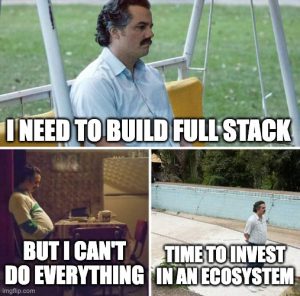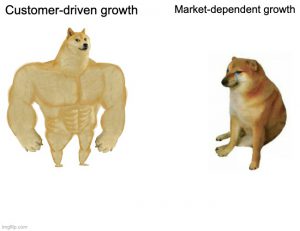Through the lens of several digital platforms serving SMEs across Indonesia, we look at how SME digitalization is being driven given the market forces that have accelerated the pace of this shift over the past two years.
Highlights
- The efforts to drive SME digitalization in the country or even other markets in Southeast Asia are nothing new, but greater trust, changes in business practices, and the emergence of functionally or vertically specific platforms, has sped up adoption significantly in the last two years.
- This catalysis has opened up a variety approaches to drive SME digitalization:
- greater digitization of data unlocking product flywheels, adoption, retention,
- larger players building horizontal ecosystems with other players,
- and supply chain digitalization enabled by industry-“localized” platforms
While SME digitalization has taken off in Indonesia over the past few years, the efforts to drive this in the country or even other markets in Southeast Asia are nothing new.
As AwanTunai CEO and co-founder Dino Setiawan shares on our podcast, it’s always been a matter of who will make it work. “I definitely feel this digitalization of the micro-merchants out there is inevitable. It will happen. The issue is, well, who’s going to figure it out. Because I think SaaS adoption is tough in Indonesia. And this is why you see that a lot of the Chinese business models simply didn’t work in Indonesia. The user base is very different.”
And even as digital adoption across SMEs has doubled over the past two years since the pandemic, there’s still a lot more that needs to be done, as CrediBook CEO and co-founder Gabriel Frans shares on our podcast. “We currently have 16 million SMEs based on government data…onboarded on digital platforms. It has grown [twofold] since the pandemic; the number was 8 million before the pandemic, and we are seeing really, really huge growth.

And the government mentioned that they want to aim for 30 million SMEs to be onboarded in 2024 if I’m not mistaken. So within the next five years, we are seeing the growth or the technology adoption in this SMEs industry will be very, very massive. That’s why we are here to provide them with technology solutions.”
The emergence of market leaders over the past two years who are able to “make it work” and will continue to “make it work” for SME digitalization has been catalyzed by:
- the emergence of massively adopted (consumer) digital platforms that has increased trust in digital solutions overall
- the pandemic forcing many businesses to shift to online channels for sales (frontend) and their supply chain (backend) needs, and
- the rise of generalist platforms has spurred entrepreneurs with backgrounds in specific industries (e.g. fisheries, fashion, agriculture) to develop verticalized platforms catered to the needs of their specific industries
These shifts in business practices and tech startup focus have impacted the way SME digital enablers have evolved to drive adoption. In particular, we tackle three areas in this article that have become pivotal for Indonesian SME enablers to drive adoption:
Access to Quality Data Stream:
(1) Data Digitization unlocking SME SaaS adoption through embedded financing
(2) Data Digitization unlocking product flywheel and greater SME retention
(3) Emergence of Startups to Build Ecosystems: Horizontal ecosystem supports verticalization focus
Focus on Industry-Specific Supply Chains:
(4) Enabling better distribution for upstream or producers
(5) Linking disconnected upstream and downstream through B2B commerce
The Data to Rule Them All
Data Digitization → Low-Cost Financing → Digitized Supply Chain Relationships → SaaS adoption

A key issue for many SME enablers, especially those seeking to enable SME financing, has been to find a reliable and sustainable source of data to build up credit profiles and drive down the costs of capital for these businesses.
But more than becoming a platform for low-cost working capital, tech companies like AwanTunai have been able to leverage this go-to-market to open up product-market fit (i.e. Sound familiar? That’s compound product-market fit) for greater adoption of SaaS solutions.
As AwanTunai CEO and co-founder Dino Setiawan shares on our podcast, both product-market fits with the digital lending and SaaS adoption are rooted in tapping into data and trust from existing supply chain relationships. “This I think is where our approach is a little bit more nuanced. We leverage the supply relationships that we’ve achieved by building a fairly large supply network out there. We’re providing our suppliers with a lot of SaaS solutions. That’s in a way driven by lending. This is not the first time anyone’s tried to put some kind of SaaS solution into the downstream supply chain. Many have tried — all the major principals, even some of the major banks that will try it. And essentially it’s all failed because tech adoption is extremely difficult in Indonesia.”
“And that’s why we really lead in with the low-cost working capital. Everybody needs that in this particular segment. And it’s the lending that actually pulls the SaaS adoption at this supplier level. And that’s how we build our supply network. And from there, a lot of these suppliers have very tight relationships with their customers. These are like micro-merchants. And this relationship is what we leveraged because there’s already trust established there.”
The micro-merchants AwanTunai works with are able to access low-cost working capital through the digitized data coming from their suppliers. With the impact of the pandemic, AwanTunai was not only able to maintain their risk discipline on the lending side of their business but also leverage the digitized data and supply chain relationships coming out of the lending business to launch SaaS solutions like SKU ordering. The specific solutions they chose to lead with stemmed from the pain points they saw in their existing customer base as well.
Dino describes on our podcast how the synergy between micro-merchants and suppliers has enabled them to drive financial inclusion for micro-merchants, and even the suppliers as well. “The micro-merchants listen to their suppliers and when we offer a much better way for the suppliers to operate, essentially digitizing a lot of their orders, where historically a merchant would write the order by hand, messy handwriting, maybe photograph that using WhatsApp and then send it to the supplier. Now it’s all essentially digitized through an app. So that simplifies a lot of the fulfillment functions that happen at the supplier. It runs through our POS system that we also provide to the suppliers. And the synergy there is when all that data starts coming into our system.”
“It makes those customers bankable, those micro-merchants that were historically simply not bankable due to a lack of any kind of credit history data or any kind of digitized transaction data, be it bank transfers or anything like that. Now, all of a sudden through AwanTunai, they become able to access the low-cost bank capital that we deploy through our platform.”
What’s important to note here apart from the value of working with existing trust and data in these relationships is the reciprocity in driving growth for both the financing and SaaS sides of AwanTunai’s business. As we’ve written on compound product-market fit, “navigating growth through progressive product-market fits are not siloed efforts. One product-market fit can lead to another. These products ultimately help each other scale and be more effective for their specific use cases…” In the case of AwanTunai, lending grows the network of adoption for their SaaS solutions while SaaS fuels data for financing.
Data Digitization Platform → Customer Feedback → Transaction Platform → Greater Retention

While CrediBook did not start with financing, they also similarly leveraged the digitization of existing data through their bookkeeping app to discover the wholesaler pain points which led to the launch of their wholesale commerce platform CrediMart and be able to unlock more transactions which could then be integrated back into the bookkeeping app. This ultimately helps their customers with (1) growing their own customer base and (2) access financing (which they don’t offer but by enabling better financial and operational reporting, it drives retention for both products overall).
CrediBook CEO and co-founder Gabriel explains this interoperability between CrediBook and CrediMart on our podcast. “[Credimart] fits into broad verticals, but how it fits into the picture is that not only do we help them with accounting, but we also help them with transactions, and these two are also integrated. If you can handle the order it will automatically [be recorded] in your bookkeeping. [It makes things work easier]. It just automates the whole process.
“For now Credibook is growing steadily. So we let it grow organically because we know that users love it. We receive really good feedback for Credimart since launching in February 2021 and currently it’s available in more than 40 cities across Java and Bali…And we are also serving a broad spectrum of product deliveries, such as not only daily goods, but also cosmetics, stationeries, construction materials, and even [products] like automotive spare parts.”
The Pieces Are Coming Together
Apart from the power of leveraging digitized data and trust in supply chain relationships to unlock more digitized transactions, SME enablers also realize that with the emergence of more players supporting the SME segment in a variety of ways, they may not always have to build everything on their own and instead invest in or acquire adjacent services once their core platform has reached a certain mass.
We need to be full-stack, but we cannot be good at everything

Fazz Financial Group, which started out as leading rural Indonesia fintech Payfazz, has taken a partnership and investment approach to grow horizontally across a variety of capabilities related to SME banking to free the group to focus on expanding vertically (i.e. their SME banking stack).
Group CEO Hendra Kwik explains this on our podcast. “When we started Payfazz, initially we focused on helping the unbanked in the rural areas to pay their bills, but as we operated the company for the last five years, we realized that finance is actually very vast, it goes beyond payments. Sometimes the people in the rural areas of Indonesia may want to pay for goods, but they also want to send money. They want to pay merchants, as well as global merchants like Spotify and Google. And they also want to buy gold or invest their money. That’s when we realized that we needed to be more than just a payment company, we needed to be a [full-stack] financial services company.”
“So we rebranded the company into Fazz Financial. But we also realized that we cannot be good at everything…In order to be able to also bring other use cases we decided to invest. So that’s why we invested in Xfers to bring in the payment gateway capability. We invested in Credibook to bring in the bookkeeping capability. That way we can bring those use cases without distracting the focus of the company on the recharge or money transfer.”
It pays to have a horizontal ecosystem to support vertical expansion. For Fazz Financial, that ecosystem has evolved in various levels, from joining forces with Xfers (payment and fintech infrastructure piece) to form the fintech group to making minority investments in companies like CrediBook (financial reporting piece) and Modal Rakyat (P2P lending piece) to being customers of companies like Verihubs (verification piece), all services that their customers can use around Fazz’s core banking stack.
Growing with customers

This vertical expansion is best done in alignment with the growth of SME customers. This was the case for Shipper, as COO and co-founder Budi Handoko, shares on our podcast, where they started initially with a dashboard for 3PL provider management, first-mile pick-up and micro-fulfillment (i.e. using local stores/mitra), then expanded to warehousing and larger fulfillment centers as their customers grow and needed more space and more complex first-mile distribution services.
“The first part is the dashboard, where you can actually monitor all the shipping within one platform basically. We have about 40 3PLs integrated, so you can pick and choose any of them for the shipping, and you can take all the orders within that particular platform. That’s the beauty of that. Customers can just go to their account and change their shipping [provider] as well.”
“And secondly, in terms of the agents’ network, when we built this platform, we believed that pickup is actually one of the most important things besides the data. For the pickups, there are two ways of doing that. We [could] have our own drivers and we just assign them to pick up, which can be costly and can be inefficient. That’s why we have built our own “mitra” or this is called agent’s network where they will help us to pick up with a revenue-sharing basis. So there’s no fixed salary or fixed cost for that. That’s how we have evolved. We get the data, we get the shipping, then we can see that “Hey, they actually need pick-up [services].” So we built an agent network.”
“The third piece, warehousing is [due to the reality], as I explained earlier, that the growth of e-commerce actually has been quite good for certain customers and they need some fulfillment services, so then they would store goods in our warehouse.”
What’s worth noting is that while Shipper continued to expand their first-mile logistics stack to cater to larger businesses, they continued to have an influx of new SMEs coming into their ecosystem using their agent network and micro-fulfillment services.
Budi shares on our podcast about the dynamic between their agent network and warehousing business. “And obviously, as we grow, people might ask if that means the agent network will be impacted. But I don’t think so because every day there’ll be more and more online sellers that come on board. So the agent network businesses won’t be impacted, while the larger businesses come to our warehouse, mainly because the agent network has limitations in capability. They’re not able to deliver 50 parcels or 100 parcels at one point because they are using motorbikes. So they become a problem in the SLA and that’s why we believe with warehousing solutions those [issues] can be resolved.”
Just like Fazz Financial, Shipper also expanded horizontally to beef up their vertical logistics stack. Budi shares on our podcast the rationale behind their acquisitions of logistics startups Pakde and Porter.
“We would trial warehousing beforehand ourselves. The challenge for that would be actually to have the know-how and also the tech stack that we need to run that operation. When we looked at Pakde, we were working together at the beginning where we helped them with the shipping. Then we realized that we could actually work together tighter to actually do fulfillment. We could see there’s a lot of synergies there. And I think that’s how the conversations started. We actually met the Pakde founders through the introduction of people that we met on a plane. I think it was destined for us to work together.”
“And for Porter, we see that they had actually very strong shipping and because they were building the same thing — building shipping networks and agent networks. Instead of us building the same thing — it’s a waste of time and resources, we thought, “Hey, we should just work together to build that agent network. So, we can save some time and win the market faster.” That was the whole idea around the acquisition.”
And beefing up their existing shipping and warehousing capabilities is just one piece of the puzzle of building that horizontal ecosystem to more holistically support SMEs and ecommerce brands and businesses in Indonesia.
It’s also worth noting what Fazz Financial’s and Shipper’s moves in their respective spaces to enable SME growth and digitalization could mean for the competitive landscape going forward, especially with respect to consolidation.
Digitalization can’t paint Indonesia with a single brush
While you have the likes of Fazz Financial and Shipper enabling SMEs from the financial services and logistics pieces of the puzzle respectively across a wide range of products, there are certain verticals or industries where digital enabler platforms need to “localize” to the nuances of that vertical or industry.
Approach 1: Enabling distribution efficiencies for producers / upstream

One of the earliest industries to get venture backing in Indonesia was the agriculture sector, with players like Sayurbox that pushed the envelope on addressing the supply chain inefficiencies from farm to table.
One unique aspect of how Sayurbox grew its platform, given the status quo of farmers unable to sell their produce entirely and their harvests limited to single distributors, is by enabling farmer harvest distribution to be diversified across their B2B and B2C channels, reducing waste and increasing the revenues of farmers in their ecosystem.
Amanda Susanti explains this B2B and B2C dynamic on our podcast back in 2020. “On one side, we built a presence in the farm areas, we built sourcing hubs in the farm areas. It’s only the uncertainty of the demand, but also the supply, so there’s a lot of things that need to be taken into consideration, with supply and demand planning. But essentially the model works around the concept that farmers want everyone to take their harvest whether it’s good grades or bad grades. So it helps that we’re doing a multi-channel demand approach so we’re not only selling to B2C, but we’re also selling to B2B.”
“So we’re able to get easier forecasting from the B2B but in case there’s external factors that influences the supply side we’re also able to flush, say if there’s an overharvest, able to flush it out to our B2C customers because the demand from that side is easier to influence from the pricing. This way it lets us get all the harvest from farmers, lets us also get better pricing, less waste in our supply chains. Currently we’ve managed to get wastage in our supply chain under 5% compared to the traditional supply chain which is upwards of 50%.”
Approach 2: Linking disconnected upstream and downstream

More recently we’ve also seen more funding going into digital solutions for fisheries businesses as well. Fishlog in particular is focusing on linking fishermen and B2B buyers, enabling the links of the supply chain to be supported on their digital platform rather than building an entire network from scratch.
As shared on their seed round press release: “While there are already existing startup-developed solutions focusing on the fishermen or farmer side of the supply chain, Fishlog ultimately aims to bring technology into the fisheries supply chain, providing strong distribution channels for fishermen and easy access for B2B buyers to get real-time fish availability. The real-time availability of fish will contribute to greater equitability when it comes to prices and solve accessibility gaps across the country’s supply chain network.”
This fragmentation of the supply chain upstream from downstream has also been a pervasive problem for Indonesia’s fashion industry as Wifkain CEO and co-founder Sara Sofyan discovered when she started her own B2C fashion business.
This is also more interesting considering Indonesia’s textile industry is one of the strongest manufacturing hubs in the region, as Sara shares on our podcast. “The textile industry is very interesting. Indonesia has been one of the strongest manufacturing hubs in Southeast Asia if not in the world. In the textile manufacturing industry, the upstream side has the knowledge, the skill, the network, the resources, the history — it goes a long way in this industry.”
“But the industry is very opaque and it’s very untransparent. And hence we see that the ecosystem is not integrated from upstream and also downstream and that is what makes the ecosystem not integrated in a holistic way and not optimizing both of the upstream and also the downstream side.”
It’s also important to consider that for each of these industries, the data (going back to our first point) can be very nuanced and specific for that industry, which means SaaS solutions, especially those covering transactions and operations, also need to be localized. This opens up massive opportunities for verticalized B2B platforms like Wifkain to lead the way in their respective industries.
Sara explains the need for a digital platform for Indonesia’s fashion industry on our podcast. “Textile itself is a very different product than all the other generic products like FMCG and everything that currently is being scaled by other startups. I think the complexity and also the detailed information in textile is very, very important, to be captured, for the consumer’s consideration to buy the items as well as for the merchant to actually manage their warehouses.
And that detailed information they’re very different from the generic products and provides a very limited available platform or technology in the market for us to use. And hence the challenge for us was to actually customize and build things that will be used and suitable enough for the merchant and the textile product itself.”
And to tie in this localization piece with our discussion on the value of growth through adjacencies and ecosystems, we see that just as with CrediBook’s bookkeeping app enabling its customers to better access financing (although it is not the platform itself owning this function, at least at this point in time), Wifkain’s platform increasing order throughput and optimizing factory utilization has also enabled merchants and factory owners to access working capital as well.
Sara shares an example from one of the merchants they worked with on our podcast. “We worked with one of our key merchants for over a year now. And before the first order when we actually worked with them, their factories were very underutilized. It’s not really good for their financial books and also the growth of the factory itself.”
“Once we engaged with them and we kept on building up orders with them, connecting them into a wider distribution network, now we actually already contribute almost 25% over their full capacity. So that actually unlocked an additional revenue of 25%, which is huge.”
“So it’s not only that the data can provide pre-approved or easier access to financing to the buyers. It also provides the opportunity of getting a lot easier working capital for the factories. So as we’re currently speaking, the fintech is currently undertaking an assessment to provide the working capital facility to the factories, which previously had very limited access to funding from any financial services companies.”
Is this finally the year of SME digitalization?
SME digitalization is less of a tipping point and more of an ongoing shift, but the past two years have shown the market that there are key fundamentals (digitizable data, critical mass of players in the competitive landscape, and localization to industries) that tech startups are able to take greater advantage of to drive adoption of digital solutions in a segment that has long been very difficult for tech to penetrate.
The biggest question mark moving forward is how the product flywheels, ecosystems, and verticalization of these SME enablers will unfold and how that affects the competitive landscape (e.g. consolidation). What’s clear is that for the time being there are now players that are better equipped to serve SMEs and SMEs have more options than ever before to beef up their own tech tooling across a variety of aspects.
Paulo Joquiño is a writer and content producer for tech companies, and co-author of the book Navigating ASEANnovation. He is currently Editor of Insignia Business Review, the official publication of Insignia Ventures Partners, and senior content strategist for the venture capital firm, where he started right after graduation. As a university student, he took up multiple work opportunities in content and marketing for startups in Asia. These included interning as an associate at G3 Partners, a Seoul-based marketing agency for tech startups, running tech community engagements at coworking space and business community, ASPACE Philippines, and interning at workspace marketplace FlySpaces. He graduated with a BS Management Engineering at Ateneo de Manila University in 2019.